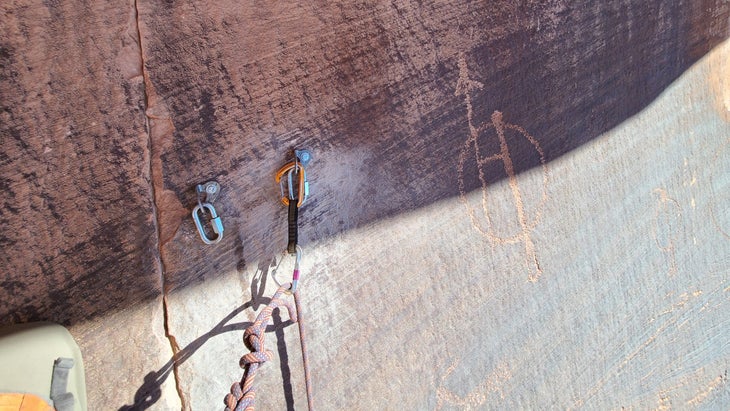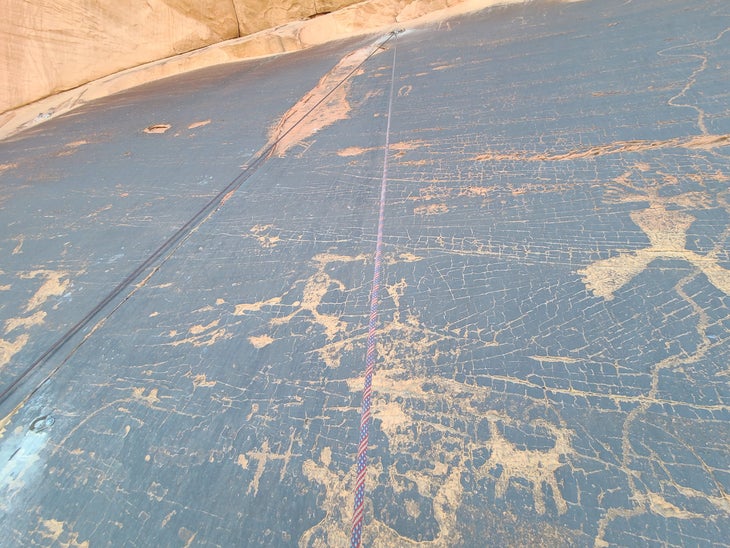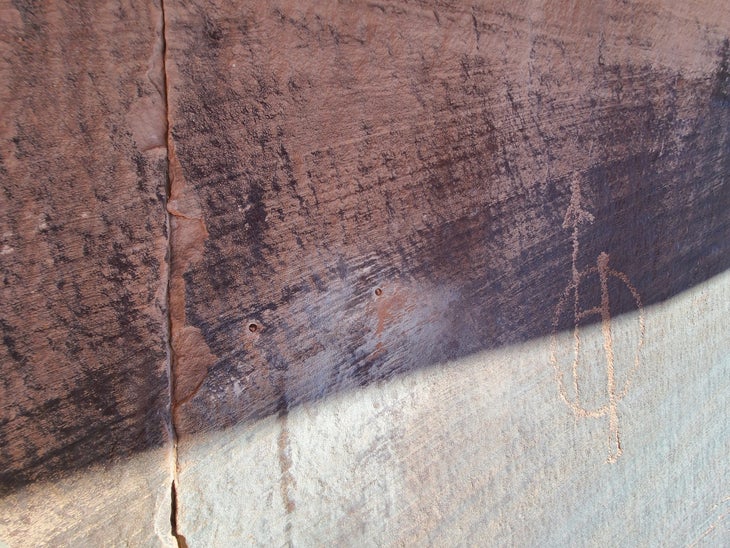Climber Bolts 5.3 Over 1,000-Year-Old Petroglyphs in Moab

When Darrin Reay and his friends arrived for a weekend of climbing at Sunshine Slabs north of Utah’s Arches National Park on Friday night, they were surprised to find a trio of easy sport routes bolted on low-angle terrain near the camping area. “My friends were like, ‘Sweet man, we got tailgate belays!’” Reay told Climbing. A flint mapper, he had been out to the area over a decade ago to check out petroglyph panels, but had forgotten about them in years since.
Reay started climbing up the middle of the three routes. “I get halfway up, and all the sudden there’s a petroglyph four inches from a bolt,” he said. “I look up, and there’s a whole panel, and the route goes right through the middle of it.” That night, Reay and his friends pulled the bolts on the first route and downclimbed. By Sunday, they had pulled the other two routes which had been bolted through the panel as well.

“These petroglyphs date from the Fremont culture, a pre-Columbian Native American culture that inhabited Utah and parts of Colorado, Arizona, and Nevada between 2,000 and 700 years ago,” said Stewart Green, a friend of Reay’s who reported the illegal bolting on Facebook.
A prolific author, photographer, and lifelong climber, Green is the author of over fifty books, including numerous climbing guides. “[The Fremont] were contemporary during the latter part of that time with the Ancestral Puebloans at Mesa Verde,” he told Climbing. “The Fremont petroglyphs are stylized images that include geometric shapes like spirals and lines, as well as anthropomorphic figures and animals. My guess as to the age of this panel is about 1,000 years. It’s difficult to date rock art unless [it is] found in association with datable artifacts.”
The trio of offending routes, Yote Dawg, Peaches, and 23 Flavors, which were originally posted on Mountain Project (and have since been deleted), were all “FA’d” at a mere 5.3, a grade which in and of itself makes any amount of bolting seem excessive, 1,000-year-old petroglyphs notwithstanding. “Put it this way:, the native people soloed up and stood there for hours on end, pecking at the rock with another rock,” said Reay. “Besides, there’s room for hundreds of routes out there without coming within 100 feet of a petroglyph,” he added. “It’s not even a good route.”
The bolter initially appeared to deny on Mountain Project that the rock art was, in fact, Native artwork, referring to it as “graffiti” in a comment exchange with Green. This claim is particularly confusing in light of a route photo caption on Peaches from the bolter, dated March 29 (nearly two weeks prior to his exchange with Green), that reads, “Petroglyph of a man holding a spear!”
“What’s really significant about this panel is there was not one bullet hole in it,” said Reay. “Not one cowboy’s initials on it. It had been 100% unmolested because you had to climb up thirty or so feet of 5.3 terrain to get to it. This is one of the few panels in the region that’s never been vandalized or molested.”
Reay, a climber of 15 years, was born on Wyoming’s Wind River Reservation and adopted at three days old; he says he is half Native American. “I was living in my woods my whole life, every chance I got,” said Reay. Formerly a rock guide for Front Range Climbing Company, he eventually “wound up with a cushy job” caretaking at Gold Mountain Ranch in Ouray. He also achieved a modicum of fame after a two-time stint on the reality TV show Naked and Afraid. As a climber, he was schooled by the likes of Jim Donini and Michael Covington. “Between those guys, I got about fifty years of experience in five years,” Reay said.

Reay was adamant that he is by no means “anti-bolting.” He has put up well over 100 routes and is especially concerned with making routes safe, always protecting R/X runouts in the lines he establishes, even if they go completely on gear for him. “I believe in ethical bolting. I love the sport,” he said. “There is just no excuse to be putting up bolts on petroglyph panels.”

Green called the incident “a travesty” and added that “the key to making sure that another incident, which makes climbers look like a bad user group, doesn’t happen again is education. As climbers, we need to do a better job educating new climbers that have learned in gyms and without mentors that we need to practice a Leave No Trace ethic where we climb, and that includes respecting sacred sites, as well as historic and prehistoric cultural resources.”
Similarly, Reay sees the repercussions of reckless bolting like this as twofold. Climbers are both destroying artwork of unfathomable historical and cultural value and endangering climbing access at spots like Sunshine Slabs in the future. He mentioned previous closures in places like Indian Creek, where dozens of routes were lost because of people climbing on the petroglyph panels at Newspaper Rock.
“Putting up a new route on public land is one of the few things you can still do that doesn’t require a permit,” Reay said. “It’s about preserving our history and preserving access for all of us.”
The post Climber Bolts 5.3 Over 1,000-Year-Old Petroglyphs in Moab appeared first on Climbing.

